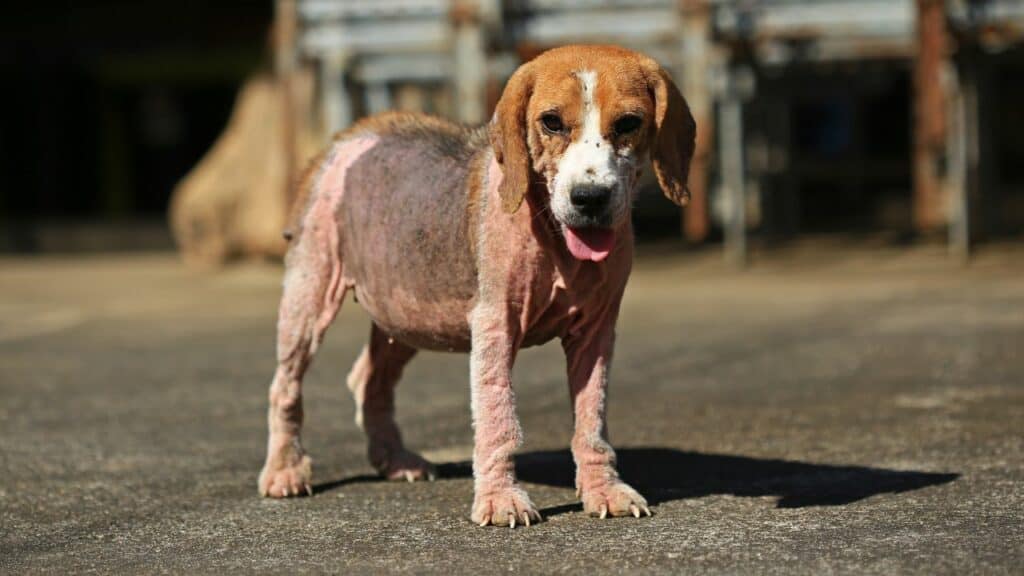Mange is a highly distressing health issue that can cause your dog much suffering.
If you don’t take immediate action, you can find yourself infected with the arthropods that cause mange.
Fortunately, several mange treatments can solve the issue and make your dog feel better.
You can also attempt a few over-the-counter medicines and at-home natural remedies in addition to these treatments, some of which will require you to see your veterinarian.
As you know now the answer to the question “how to treat mange in dogs at home “, we’ll go through the home remedies for mange, the general approach to therapy, and some of the most effective solutions.
Home Remedies To Handle Manage At Home

There are several possible home remedies for mange.
Mange may be treated at home with bathing, spot cleaning, or food additives, but it is preferable to contact your vet if any home therapies are inefficient.
Let’s have a deeper look into the different possibilities.
OTC Mange Medications
There are a few OTC treatments for mange that you might want to look into.
The majority of over-the-counter treatments for dog mange are created with different plant oils and are unlikely to be effective treatments.
Sulfur is present in at least one product, happy jack sarcoptic mange medicine, and appears to work well in many instances.
These are probably most commonly used to treat ringworm, but they’ll also eliminate mange mites.
You must use happy jack mange medicine cautiously and avoid getting it in your pet’s eyes.
Medicated dog shampoo will also work fast to relieve symptoms, including inflamed scalp for dogs suffering from mites.
While you should use a shampoo designed to kill mites if your dog has mange, you can also use a regular dog shampoo as a general rule.
Before administering this medication to your dog’s entire body, it is advisable to test it on a tiny patch of skin on his body to ensure that it won’t irritate his skin.
Flea Treatments
A few prescription flea medications can kill sarcoptic mange mites, but Frontline Plus also has some other mange-fighting qualities that make it worthwhile.
Frontline Plus is a fipronil-based topical drug predominantly used to treat flea and tick infestations, while it may also be effective against mite infestation.
Although Frontline Plus does not assert to treat mange, other fipronil-based medications have been demonstrated to be successful in getting rid of sarcoptic mites.
Therefore, you should generally think of Frontline Plus as a part of a thorough mange-treatment plan.
Moreover, Frontline Plus won’t hurt anything because your dog requires an efficient flea and tick treatment.
Olive Oil
Some dog owners prefer to use olive oil to treat minor localized mange problems; smear a little oil coating over the skin’s problem on your dog.
The oil will aid in rehydrating your dog’s skin, smothering any mites there, and halt their constant irritation.
To coat your dog’s entire body with oil would not only be expensive, but it would also make a huge mess all over your home.
However, while this treatment may be helpful in highly mild cases of localized demodectic mange, it won’t benefit infected dogs fighting systemic skin disease.
Olive oil is one of the most excellent home remedies to try, whether it works or not, as it is safe and easily accessible.
The main challenge will be to stop your dog from simply licking it off.
Aloe Vera
Some owners have utilized aloe vera plant extracts to cure mange.
These extract helps to calm the skin, lessening the inflammation and discomfort that demodectic mange mites produce.
Additionally, it demonstrates a few minor antibacterial properties that might aid in preventing localized mange infections from developing.
Extracts are also said to kill tiny parasites; however, we haven’t been able to discover a reliable source to back up this claim.
Any thick liquid, gel, or paste could suffocate mites residing on your dog’s skin.
Extracts are often administered to the affected areas a few times a week until the mange clears up.
As a result, this home remedy is only effective for localized demodectic mite infestations, similar to oil therapy.
Additionally, you must avoid your dog swallowing aloe vera extracts because they are poisonous to them.
You may have to fit your dog with an e-collar during this time.
Dogs who consume aloe vera typically have vomiting or diarrhea, though depression and muscle spasms can occasionally happen.
Yogurt
That is another home remedy to cure sarcoptic mange.
Most dog owners who use it to cure mange spread it to the affected region.
Similar to olive oil, plain, unsweetened yogurt is healthy for canines.
It is packed with natural probiotics, so it’s not a big issue if your dog licks the yogurt off his skin.
If yogurt works, it will probably be because it suffocates most of the mites on your dog’s skin.
Although this has not yet been scientifically shown, it probably benefits skin irritation a little, and the probiotics it contains may help remove the fungus on your dog’s skin.
Therefore, there is no reason why you can’t try yogurt on dogs who have mild, localized sarcoptic mange; it might not work, but it shouldn’t result in many significant issues.
Lemon
Particular lemon juice and water concoctions are occasionally advised for treating mange.
To the afflicted area, they are often applied topically.
However, depending on the source you consult, you’re typically looking at a whole lemon or two in a liter or two of water.
These mixes occasionally have garlic added.
The idea is that the acidity of the final mixture will kill the mites that are now dwelling on your dog’s skin.
Since many citrus fruits are known to have antiseptic characteristics, it might also help to get rid of some of the germs or fungi already there.
Lemon may or may not have the desired effect because there is a significant variation between how it behaves in a petri dish and how it behaves on your dog’s skin.
Although your dog is unlikely to consume much juice and it is not harmful, it could irritate their skin.
As many helpful bacteria on your dog’s skin will probably be eliminated, it could worsen existing skin problems.
We’d generally discourage owners from trying this particular home remedy.
Honey
Honey has excellent medicinal qualities and can treat a wide range of conditions in both humans and other animals.
The sore, delicate skin will heal thanks to its antiseptic and antioxidant properties, which will also help the dog’s immune system.
Honey can also rid the skin of beneficial bacteria, dog’s mange-related filth, and grime.
For treatment, directly apply honey to the skin lesions on your dog.
Although untidy, this procedure may be beneficial.
Apple Cider Vinegar
The mange mites may be removed with an apple cider vinegar soak. Borax and warm water are combined with half a cup of apple cider vinegar.
Before applying the mixture to your dog’s skin and coat, ensure the borax is completely dissolved.
Additionally, watch out that your dog doesn’t lick the liquid because Borax ingestion might be dangerous. If required, wear an Elizabethan collar.
When applying the mixture to your dog’s body and coat, bypass the mouth and eyes; let the solution air dry without towel drying.
Without bathing the entire dog, you can apply the same solution in a spray bottle to smaller patches of skin and fur on your dog.
Small pets or small impacted areas are ideal for this.
Apple cider vinegar can also be added to your dog’s food or water.
Mange can be treated by adding a teaspoon for dogs under 30 pounds or a tablespoon for dogs over 30 to their food bowl.
Due to its antiseptic and antibacterial attributes, apple cider vinegar will aid your dog’s recovery and help maintain the proper pH levels.

Never Use Borax Dips – It’s Dangerous
Most dogs with mange are frequently treated with homemade dips made of borax.
These are not a good idea, even if they are probably more efficient than other popular home remedies.
We won’t even provide a recipe for these dips because they could be harmful.
Borax is a laundry detergent that most likely kills mites rather effectively.
Borax-based remedies might work wonders to eradicate mites from floors or inanimate items.
However, ingesting borax can be dangerous.
In the best-case situation, your dog may merely have gastrointestinal discomfort, but if it overheats, it may also result in convulsions or even death.
Borax is also incredibly drying to the skin.
That can aggravate your dog’s skin even further and raise the likelihood that your dog will get bacterial infections.
Dog Mange Symptoms
Both sarcoptic and demodectic mange typically present similar symptoms.
Some of the most common mange symptoms include:
Hair loss
Red, irritated skin
Scaly or scabby skin
Demodectic mite infections don’t frequently result in severe itching, although sarcoptic mite infestations often do.

Your dog’s elbows, armpits, and abdomen are common locations for mites to feed because they have very little hair in those places.
Pet owners frequently observe mange near the margins of the ears, especially when sarcoptic mites are present.
Best Thing To Do: Consult Your Vet
The most effective course of action If you suspect your dog has mange, the best thing you can do is take him to the vet right away.
To begin with, your veterinarian might be able to confirm that the issue is, in fact, mange (several other skin ailments can cause very similar symptoms).
For your veterinarian to be confident in a diagnosis of mange, a physical examination may not always be necessary.
However, scaly skin scrapings or hair plucks (in the case of Demodex mites) can also be taken to provide additional evidence; demodectic mange is an irritating skin condition caused by mites of the genus Demodex.
Then, presuming mange is the issue; your veterinarian can offer drugs that will rapidly solve the problem.
Mange can be treated with a variety of medications; among the most typical are:
Amitraz
Imidacloprid
Selamectin
Sarolaner
Fluralaner
Afoxolaner
If none of those work, your veterinarian may suggest ivermectin injections or a flea medication that contains the drug (although ivermectin shouldn’t be used on Collies or other herding breeds due to safety concerns).
In some circumstances, milbemycin may also be prescribed, even though this is “off-label” use.
Your veterinarian can treat any bacterial or fungal infections brought on by the mite and give you the best mange treatments now available.

Note that demodectic mange, also known as red mange, is not as severe as the sarcoptic nerve, but it can be highly contagious among other dogs.
How To Prevent Dog Mange
The best way to avoid a dog getting mange is to keep him clean and healthy.
The general health of your dog depends on maintaining the skin’s and coat’s hygiene.
Additionally, you must claim the dog’s bedding in a tidy state.
Keep your dog away from dogs or other animals you know have mange; a good diet and regular brushing can help keep your dog mange-free.
Make sure to follow up with baths and washes if your dog spends a lot of time outside or around other dogs in parks and other places.
The best way to prevent demodectic mange is to keep your dog or puppy’s immune system in tip-top shape.
Healthy dogs with well-functioning immunity are much better able to resist parasitic mites.
Pay special attention to your dog’s coat and dry skin to detect any problems.
Total Household Hygiene

Sarcoptic mites can live on your dog, but it’s crucial to remember that they may also travel to your dog’s bedding (demodectic mites don’t do this).
They might even end up on your couch, bed, or carpeting.
Therefore, when treating canine mange, you should thoroughly clean your home and wash the toys to guarantee your dog’s therapy is effective and to lessen the possibility of the adult mites spreading to the human members of your family.
To get rid of any pests hiding in your sheets and blankets, wash your linens in hot water and dry them in a high-heat setting.
To assist in destroying any bugs hiding in your carpet’s fibers, steam clean them.
It would help if you also replaced or washed any fabric that may have become infested, such as the cushion covers for your couch.
Before You Go…
Now you know the answer to the question, “How to treat mange in dogs at home?”.
If you want to learn more, read the following articles too!


